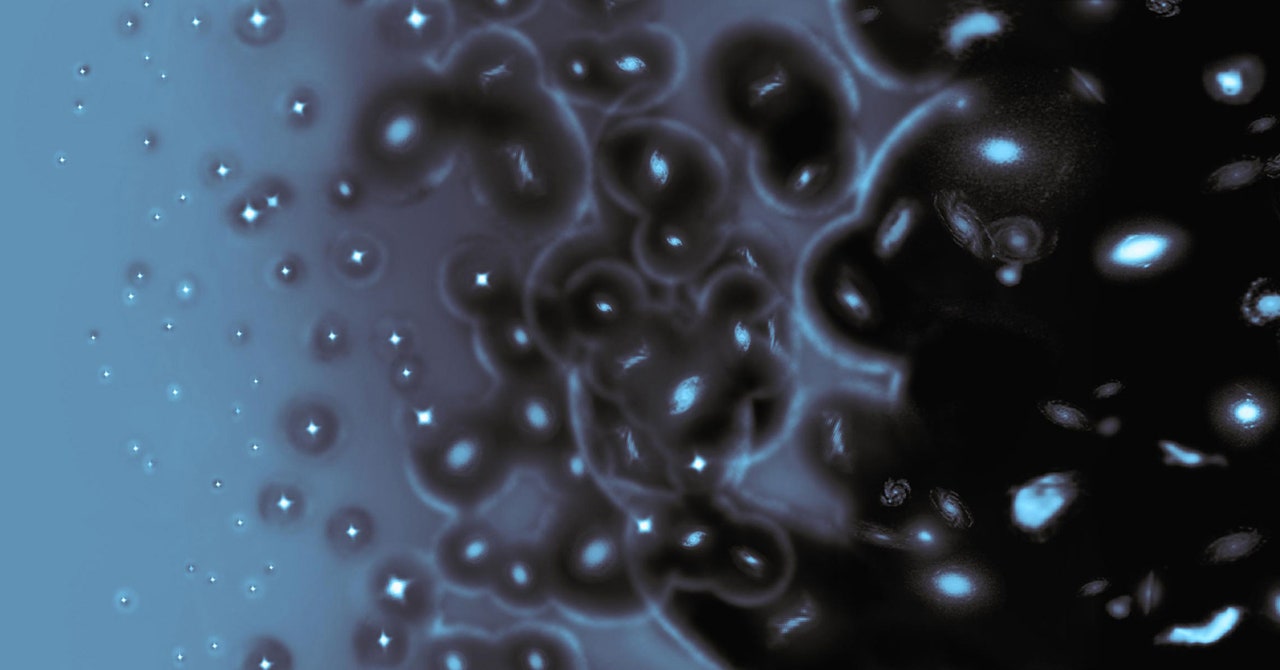
When hydrogen atoms first formed, they absorbed and then emitted ambient 21-centimeter radiation at equal rates, which made the clouds of hydrogen that filled the primordial universe effectively invisible.
Then came cosmic dawn. Ultraviolet radiation from the first stars excited atomic transitions that enabled hydrogen atoms to absorb more 21-centimeter waves than they emitted. Viewed from Earth, this excess absorption would appear as a drop in brightness at a specific radio wavelength marking the moment the stars turned on.
In time, the first stars collapsed into black holes. The hot gases swirling around these black holes generated x-rays that heated hydrogen clouds throughout the universe, increasing the rate of 21-centimeter emissions. We would observe this as an uptick in brightness at a slightly shorter radio wavelength than that of the older light. The net result would be a dip in brightness over a narrow radio wavelength range, like the one detected by EDGES.
But the observed dip, which occurred around a wavelength of 4 meters, was not what theoretical cosmologists had expected: The timing and shape of the trough were off, indicating that the first stars turned on surprisingly early, and that x-rays flooded the universe soon afterward. Stranger still, the dip was very pronounced, suggesting that hydrogen in the early universe was colder than theoretical models predicted, possibly because of exotic interactions with the dark matter that fills the cosmos.
Or perhaps the EDGES dip had a more mundane origin.
Hydrogen’s 21-centimeter emissions from the cosmic dawn era reach Earth with wavelengths of several meters, in the range used for FM radio and television broadcasts; that’s why EDGES operated in such a remote location. What’s more, the signal is overwhelmed by radio emissions thousands of times brighter from our own galaxy, and it’s distorted by its passage through the upper layers of the Earth’s atmosphere.
No less important are subtle effects from the antenna itself. A radio antenna’s environment can slightly change the area of the night sky to which it is sensitive. In such a precise experiment, even faint reflections off surfaces tens of meters away can matter. The effect of such reflections would be enhanced at certain radio wavelengths, resulting in a small variation in the antenna’s observing area—and thus potentially in the measured brightness—at different wavelengths.
The EDGES team did see this kind of ripple in their data, and the prime culprits, perhaps fittingly, were the edges of a 30-meter-wide metal screen placed on the ground surrounding the antenna to block radio emissions from the ground itself. The team corrected for possible reflections off of these edges in their analysis, but as some astronomers noted at the time, if the correction was even slightly off, the result could be a dip in background brightness over a narrow wavelength range indistinguishable from a real cosmic dawn signal.
The SARAS team took a different approach to antenna design in pursuit of more uniform sensitivity across all wavelengths. “The entire design philosophy is to preserve that spectral smoothness,” said Saurabh Singh, the lead author on the SARAS paper. The antenna—an aluminum cone propped on a Styrofoam raft—was floated in the middle of a placid lake to ensure there would be no reflections for more than 100 meters in any horizontal direction, which Parsons called “a really cool and innovative approach.” Moreover, the slow speed of light in water reduced the effect of reflections from the lake bottom, and the uniform density of the water made the environment much easier to model.


